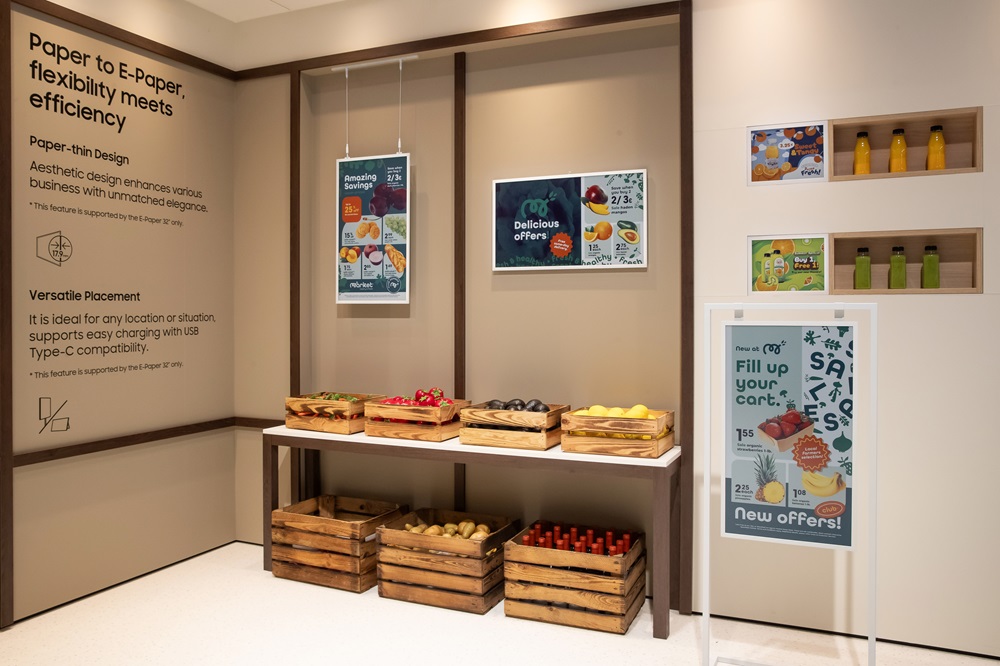Samsung is eager to establish a strong presence in the rapidly growing digital signage market. It had earlier launched the Color E-Paper EMDX series in June this year, which included the model featuring a 32-inch color e-paper display. With its e-paper digital signage solutions, Samsung aims to offer businesses something that combines the visual neutrality of paper with digital flexibility. That includes devices that are light and sleek, while being power-efficient, which reduces reliance on static printed materials.
The EMDX model is intended for spaces like shops, restaurants, public transit, lobbies, etc., where displays are on for long hours and where factors such as cost of electricity, maintenance, and visual fatigue all matter. Samsung positions this display as a greener and more energy-efficient alternative to classic LCD / LED signage on one hand and printed paper-based signage on the other.
Key Specifications & Features
Here are the standout technical details of the 32-inch Samsung Color E-Paper (EM32DX) model:
| Spec | Value / Description |
| Display Type | E Ink Spectra 6 Color e-Paper, capable of showing 6 colors (Red, Green, Blue, Yellow, White, Black) and additional color via dithering. |
| Size / Resolution / Form Factor | 32-inch diagonal; QHD resolution (2,560 × 1,440 or 2,544 × 1,400 depending on source) in a 16:9 aspect ratio. |
| Physical & Mounting | Ultra-thin: ~17.9 mm depth; weight ~2.4 kg (excluding battery) / ~2.5 kg including battery. VESA mountable (200 × 200 mm); even bezels ~13.9 mm. Works in both landscape & portrait modes. |
| Power & Battery | Built-in 4,600 mAh battery. If content is changed only once per day, battery life can stretch up to almost 200 days. Also, when the image is static, e-paper displays typically consume almost zero power. |
| Connectivity & OS | Runs Samsung’s Tizen 8.0 operating system and comes with 8 GB of storage. Connectivity is established via USB-C, which can be used for data transfer as well as recharging the battery. Other connectivity options include Wi-Fi and Bluetooth. There’s also support for content management through Samsung’s E-Paper mobile app, VXT platform for scheduling, remote control, etc. |
| Other Features | Paper-thin design, low power consumption, built with recycled materials (some parts). Packaging, too, is made from materials that are aimed at reducing environmental impact. Bezel is done up in Gray White, with a non-glossy frame. |
What About Tablets or Smartphones?
Many readers wonder, as Android Authority stated, if it would be feasible for Samsung to launch a tablet or smartphone featuring this sort of color E-Paper display technology? The short answer to this would be: maybe someday, but with caveats right now:
Pros:
- Eye comfort: E-Paper display is reflective in nature, given that it does not emit light the same way as traditional displays, such as OLED / backlit LCDs do. This makes reflective displays easier on the eyes.
- Lower energy use for static content. There is little to no power drawn as long as the image remains static. For instance, Samsung is claiming battery life of up to 200 days if the display is changed once per day.
- Slim and lightweight build. The Samsung 32-inch display is thin and relatively light for its size, which makes it easy to carry and install.
Cons / Limitations:
- Refresh rate is much lower than typical smartphone or tablet displays. Since E-Paper displays have slower refreshes, animations, video, or rapid scrolling are never as smooth as on traditional displays. Instead, what you have is lag or sluggishness, and ghosting. The latter refers to the presence of remnants of the past displays that continue to linger even after the display has changed.
- Color limitations: the Samsung EMDX, based on the E Ink Spectra 6 display technology, is capable of showing only 6 discrete colors, along with some more via dithering. That might be fine for signage, posters, menus, and such, but it will fall short for media consumption. That includes photos and video where color e-paper displays lag seriously compared to full-color OLED or high-end LCD.
- User interaction / touch: The current EMDX seems optimized for display/signage rather than heavy touch interactivity.
So while it would be “nice” to have a phone or tablet version, as of now, it seems not quite feasible to match all the expectations of a modern smartphone (smooth animations, rich video, camera previews, etc.) using this kind of color e-paper tech without trade-offs.

How This Compares / Contrasts with TCL’s NXTPAPER
Readers often bring up TCL when talking about eye-friendly displays. Here’s how NXTPAPER relates:
- NXTPAPER is not E-Paper / E-Ink tech in the strict sense. It’s a full-color LCD (or similar transmissive display) enhanced with layers/filters to reduce blue light, reduce glare, and mimic paper in certain lighting or mode settings. It uses matte surfaces, anti-glare, etc.
- TCL phones with NXTPAPER often have special modes: “Max Ink Mode”, “Ink Paper Mode”, etc., which desaturate colors (or go monochrome), reduce blue light, etc., to reduce eye strain. But they still refresh frequently (they behave more like LCDs) and don’t have the ultra-low power idle behavior that true e-paper offers.
- In many reviews and user comments, people praise the comfort of NXTPAPER displays, particularly for reading or long use. But they also note that NXTPAPER (while better than many LCDs) still can’t match reflective e-ink or color e-paper for outdoor visibility or ultra-low power when static.
Thus, NXTPAPER is more of a “best of LCD with some paper-like comfort” solution, whereas Samsung’s Color E-Paper aims more directly for that e-paper spectrum (low power, reflective/static behavior) but with the color compromises and slow dynamics that come with it.
Samsung’s Experience with E-Ink / E-Paper (Historical Context)
It is worth mentioning that this isn’t the first time Samsung has worked on E-Ink displays:
- Long back, Samsung produced e-reader devices, though they exited the segment way back in 2010.
- So, with the EMDX, it’s sort of a revival or pivot: rather than personal e-readers, Samsung is going for digital signage aimed at business applications.
Limitations & What Must Improve
To make this kind of display more usable in phones/tablets, several tech challenges need to be solved:
- Increase refresh rate / reduce latency to allow smooth UI, and video playback.
- Broaden color gamut and saturation (more than just 6 colors + dithering)
Conclusion
Samsung’s Color E-Paper EMDX is a strong step forward for signage: combining aesthetic elegance, excellent power efficiency, and flexibility. For businesses wanting visually pleasing, sustainable display options, this could replace posters and static prints in many settings. However, for personal device use (smartphones/tablets), the technology isn’t yet fully there: refresh, color, and interactivity remain challenges.
TCL’s NXTPAPER is a useful contrast: offering more “everyday usability” at the cost of many of e-paper’s power advantages. Both approaches show demand for displays that are easier on the eyes and more sustainable.
For readers: if you care about eye comfort or want lower-power display tech, this is a trend worth watching. But for now, enjoy the signage version—and maybe in a few years, we’ll carry a color e-paper phone or tablet in our pockets that doesn’t feel like a compromise.



